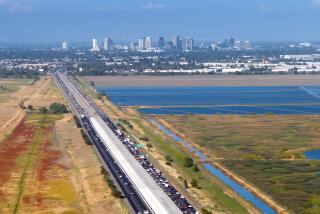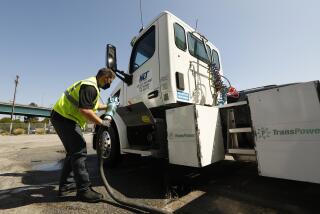A Call for Segregating Truck Traffic
- Share via
WASHINGTON — The mismatch between big rigs and family vehicles is a source of constant tension and random danger on the nation’s freeways as trucks bear down on minivans and cars cut in front of fully loaded semis.
With truckers and car drivers blaming each other for more than 450,000 crashes and 5,000 deaths a year, Congress is giving serious consideration to separating the rival streams of traffic.
A plan to be announced today on Capitol Hill calls for new “truck freeways” on interstate highways that would allow heavier, longer trucks than now permitted, but would keep them apart from cars. The special lanes would be open to “long double” and triple trailer combinations, as well as trucks currently allowed on the interstate.
Truck freeways could be built on existing highway medians, and would be separated from car lanes by concrete barriers. They would have their own entrance and exit ramps, as well as staging areas to assemble and disassemble trailer combinations. The cost would be financed with tolls paid by truckers.
The plan was drafted by the Los Angeles-based Reason Foundation, a Libertarian think thank. Proponents--including House Transportation Committee Chairman Don Young (R-Alaska)--say it would reduce the number of deaths from crashes between cars and trucks while also benefiting the industry. Bigger trucks are more efficient to operate, leading to higher profits.
Young would like to include a pilot program to test the idea in next year’s highway bill, an aide said.
It could be years before the pilot program leads to changes on a national scale because of the extensive construction work that would be needed, the aide said.
An economic feasibility study by the Reason Foundation found that special lanes would reduce costs associated with the trucking industry by $10 billion to $40 billion a year. This includes efficiency savings for trucking companies as well as maintenance savings for state highway departments from less truck-related damage to freeways. The think tank proposed that trucking companies receive a tax credit to offset the additional tolls they would pay.
Among transportation issues, truck safety ranks as one of the most emotional; 80% of the victims killed in crashes involving large trucks are occupants of smaller vehicles. The government has set an ambitious goal for reducing deaths from truck crashes, but the number has remained at around 5,000 a year since 1994.
“We would not be adding a single heavy truck to any lane of interstate,” said Robert Poole, a policy analyst with the Reason Foundation and one of the plan’s authors. “In fact, there is going to be some shifting of existing truck traffic to these lanes. Big gains for safety would come from separating the cars from the trucks.”
Dr. Jeffrey Runge, head of the National Highway Traffic Safety Administration, said the idea deserves consideration, but he had not seen enough information to make a judgment.
“It’s simple public health mitigation,” Runge said. “While the principle makes sense, the devil is always in the details.”
The National Safety Council, a leading advocacy group on auto safety, supports the plan. “We think this is a really interesting new idea that has the potential of advancing safety,” spokesman Chuck Hurley said. “It’s going to require a full and fair debate, [but] by separating trucks and passenger cars, there can be substantial safety benefits.”
However, another group, Advocates for Highway and Auto Safety, said it could not support longer, heavier trucks.
The federal government currently limits trucks to a gross weight of 80,000 pounds. The Reason study concluded that the technology exists to safely operate tractor-trailer combinations almost twice as heavy.
“A 4,000-pound automobile will be destroyed in any collision with a large truck, regardless of whether the truck weighs 80,000 pounds, 97,000 pounds or 150,000 pounds,” the Reason study said. “To make highways safer, policymakers should shift their focus on weight and size restrictions to ... separating automobiles and trucks wherever possible.” California does not permit triple trailer combinations or long doubles. Poole said the Interstate 5 corridor would be an ideal candidate for the special lanes. The truck tollways would have specially reinforced pavement to accommodate the huge rigs.
Trucking industry officials expressed guarded interest in the idea.
“We have had people in the past get very emotional about these issues,” said Warren Hoemann, a spokesman for the California Trucking Assn. “Any proposal to increase size and weight must be a proposal for safe operations, must protect the highway infrastructure and has to make practical business sense.”
The American Trucking Assns., an industry federation, will take a close look at the idea, spokesman Mike Russell said. “This is a very complex proposal and we are likely to have members on both sides of the issue. If there is some sort of offset for the proposed tolls, that would make this worth looking at.”
More to Read
Sign up for Essential California
The most important California stories and recommendations in your inbox every morning.
You may occasionally receive promotional content from the Los Angeles Times.










